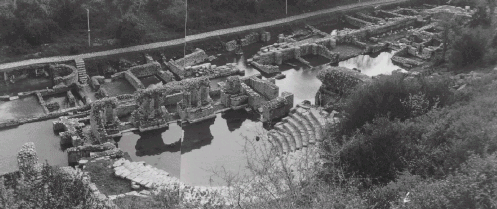Albania
> Butrinti
The city of Butrinti (Bothrota) is one of the
fragments which form the fabric of Albania's ancient
cultural landscape. Nestling in the highlands
in the far south of the country and surrounded
by dense vegetation, Butrinti was doubly protected
by nature and by the fortifications which its
inhabitants built in ancient times. However, this
was not sufficient to isolate the city from the
rest of the world. Less than ten kilometers from
the island of Corfu, Butrinti was linked to the
Mediterranean by the Vivari canal, which ran from
the Butrinti Lake to the Ionian Sea.

The amphitheater of Butrinti and its surroundings
(Photo by Petrit Omeri) |
The proximity of the sea and the lake, the gentle
climate and the beauty of the surrounding countryside
provided a splendid environment for the foundation
of a city. In taking advantage of this site, the
architects of the past constructed what was to
become one of the major maritime and commercial
centers of the Ancient World. Butrinti reached
the height of its glory in the 4th century B.C.,
at which time the city numbered 10,000 inhabitants.
The sight of the fortifications alone, which date
from the 6th century B.C., evokes the military
and economic potential of the city at that time.
The hill on which the acropolis stands is encircled
by a wall built of huge stone blocks. In places
this wall is two meters high and 3.5 meters wide.

|
The amphitheater, dating from the 3rd century B.C.,
bears witness to the cultural riches of the city.
The stone banks of seating, of which twenty-three
rows have been preserved, would have held an audience
of 1,500. The theater is situated at the foot of
the acropolis, close by two temples, one of which
is dedicated to Asclepios, the Greek god of medicine,
who was worshiped by the city's inhabitants. Approximately
thirty inscriptions, almost all in ancient Greek,
carved the western facade of this temple, and another
hundred or so found on a tower which was rebuilt
in the 1st century B.C., are the only examples of
writing discovered in Butrinti. These inscriptions
are mainly concerned with the liberation of slaves.
Excavations have brought to light many objects
- plates, vases, ceramic candle sticks - as well
as sculptures, including a remarkable "Goddess
of Butrinti," which seems to completely embody,
in the perfection of its features, the Greek ideal
of physical beauty.
For centuries, the walls faithfully defended Butrinti,
but no wall is invincible, and these huge blocks
of stone finally ceded to the assault of the Roman
legions which landed on the Adriatic and Ionian
shores in the 2nd century B.C. Under the rule
of the occupiers, Butrinti was to fall slowly
into decadence. In spite of this, three monumental
fountains, three public baths, a gymnasium decorated
with mosaics, and especially the aqueduct constructed
during the reign of Augustus, prove that the site
was not completely abandoned. Augustus also oversaw
the reconstruction of all the ancient city walls
and the erection of new fortifications.

|
Christianity brought new life to Butrinti. The
palaeo-Christian period adorned the city with
two basilicas and a baptistry, which is among
the most beautiful in the Mediterranean region.
Sixteen granite columns, forming two concentric
circles, support the roof of the main hall. The
floor is paved with a magnificent mosaic representing
the Tree of Life and decorated with medallions
embellished with animal motifs.
Barbarian incursions and Norman raids in the eleventh
century, a catastrophic earthquake in 1153, conquest
by the Venetians in 1386, the subterranean infiltration
of water and the subsequent epidemics completed
the ruin of the city and forced the inhabitants
to flee. Butrinti was buried in silence and oblivion.
Throughout the occupation by the Ottoman Empire,
from the 15th to the 20th centuries, the city
remained in deep slumber. The waters covered Butrinti
in mud, and abundant vegetation completely hid
the remains from view.
It was not until the beginning of the 20th century
that systematic excavations were carried out at
Butrinti by the Italian archeologist I. Ugolini,
followed by his compatriots P. Marconi and D.
Mustili. Between 1928 and 1941, the ground was
cleared and the ancient city gradually began to
reveal its hidden treasures.
Following the liberation of Albania in 1944, Albanian
archeologists undertook more ambitious excavations.
In turn, the ramparts, the acropolis, the agora,
the amphitheater, the temples, public baths and
private residences re-emerged into the light of
day. The entire city arose, almost intact, under
the fascinated gaze of the archeologists. The
mud and vegetation that covered Butrinti had protected
it from the natural and human ravages of time.
Today, this rediscovered city represents a unique
cultural treasure whose value far surpasses national
frontiers. The importance of Butrinti can be gauged
from its inclusion in 1992 on UNESCO's World Heritage
List.
Text entitled Butrinti Rediscovered
by Prof. Zija Xholi of the University of Tirana.
|